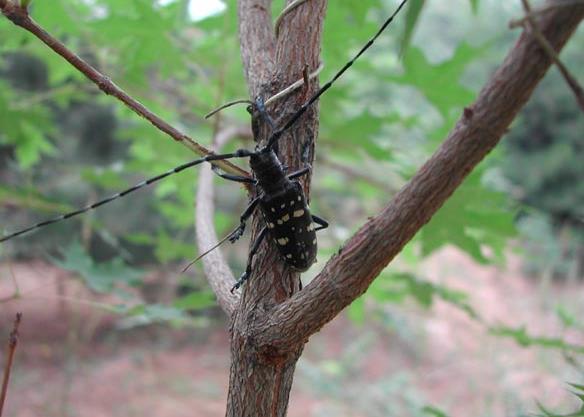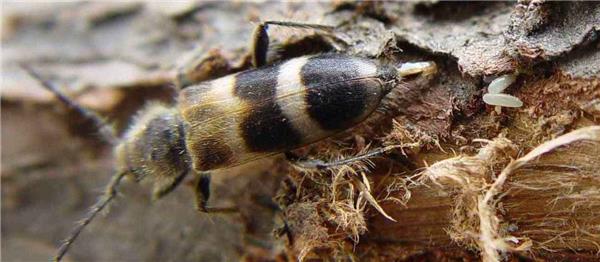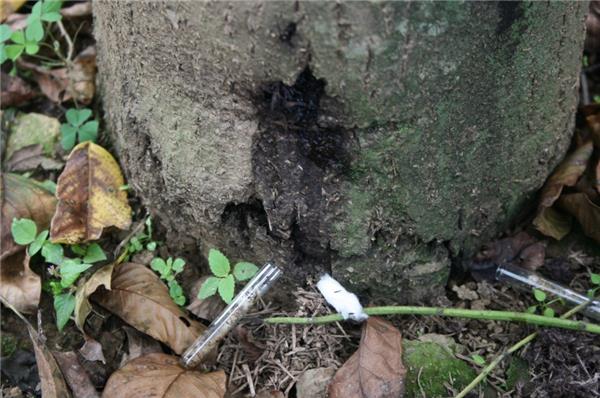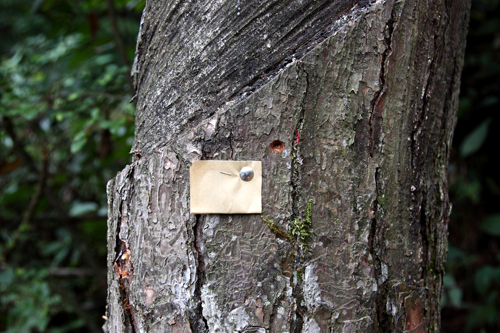The harm of longicorn beetles to plants and the control methods of longicorn beetles
Longicorn beetle is a kind of ugly bug, which makes people get scared easily after watching it. Moreover, it not only looks bad, but also does great harm to trees. It is really a kind of bug that people can't love.

Morphological characteristics and occurrence regularity of longicorn beetles
Longicorn beetles belong to the family Cerambycidae of Coleoptera. Longicorn beetles commonly harmful to trees include longicorn beetles, red-necked longicorn beetles, mulberry longicorn beetles, bare-shouldered longicorn beetles and so on. The larvae eat the trunks and branches of coniferous or broad-leaved species (such as apple, cherry, peach, plum, poplar, willow, Robinia pseudoacacia, white wax, Populus tomentosa, Pinus koraiensis and other trees).
Longicorn beetles usually occur in 2 ~ 3 years. Most of the adults appeared from June to August, but they occurred more frequently from late June to July. After the emergence of adults, first eat the bark, and then lay eggs, the egg period is about 10 days, that is, the larvae begin to hatch. The newly hatched larvae first feed on the cambium under the bark and gradually decay into the xylem with the increase of the instar, and the sap often flows out of the wormhole.

The harm of longicorn beetles
Longicorn beetles are important pests of street trees, shelterbelts, courtyard parks, green trees and stump bonsai in factories and mining schools. Trees suffer more seriously, and a few species harm herbaceous flowers. The larvae eat the trunk and roots, resulting in poor growth of trees, weakness of trees, withering and breaking of branches, and serious death of the whole forest after several years of continuous damage. The damaged trees are often damaged by phloem and xylem, and the transport of nutrients and water is blocked, while the tree is weakened and grows poorly; the seriously damaged trees are vulnerable to wind break, or the whole tree dies because the trunk is eaten, so the use value of its wood is reduced. Longicorn beetles discharge feces to worsen the environment. Adults bite on the skin of twigs, causing shoot withering, especially Monochamus alternatus, which not only directly harms, but also spreads pine wood nematodes, causing large areas of pine forest to die, so it is an important quarantine pest.

Non-drug control methods of longicorn beetles
1. Carry out quarantine. It is strictly forbidden to introduce dangerous longicorn beetles from abroad, outside provinces, cities and counties through logs, packaging wood and insect-carrying trees.
2. Select insect-resistant tree species and varieties. Different garden tree species and varieties have significant differences in resistance to longicorn beetles, so the tree species or varieties with light harm should be selected.
3. Strengthen the management of gardens. Combined with pruning, timely pruning and treatment of insect withered branches; weak trees are vulnerable to longicorn beetles, so forest management should be strengthened to promote vigorous growth and reduce the harm. Monochamus alternatus and other trees are about to die or are already dead. Every year, before the adults fly out, they are cut down in time to thoroughly clean up and deal with the dead trees in the forest.
Drug control methods of longicorn beetles
1. Green Weilei: conventional spray with a sprayer, diluted 300 to 400 times, the diluted liquid is sprayed on tree trunks, twigs and other places where longicorn beetle adults like to appear above the ground. Spray on cloudy and rainy days, if it rains within 6 hours after application, the efficacy will be greatly reduced.
2. Chloramidophos: dry: chloramidophos has a very strong internal absorption, it can scrape off the old bark 20 inches wide, slightly expose the green bark, wind the wet cloth soaked with chemicals in the scraping place, or dry it with a brush dipped in the solution. Making use of its permeability, the liquid can be quickly inhaled into the tissues and organs of the plant, and the ideal control goal can be achieved when the pest eats the part containing the liquid. The concentration of the solution is 1:1. The method is suitable for use when the population density is low. Bandage the application area with nylon film after quarantine to avoid poisoning by accidental ingestion of poultry. Injection: when controlling dry borer pests, the medicine can also be directly injected into the plant by drilling and injecting medicine, and the medicine solution can be delivered to the feeding place of the pest through the internal absorption and conduction of the plant, and the pest will be poisoned and killed when it eats the plant tissue containing the medicine solution. The concentration of the solution can be controlled between 1 and 5 to 10. It is not restricted by the density of insect population.

Longicorn beetle pests occur almost every summer, so we must be careful and strict in the process of planting and maintaining plants, and never give them any chance to hurt plants.
- Prev

Management and maintenance of seedlings and flowers in different periods and different occasions
Management and maintenance of seedlings and flowers in different periods and different occasions
- Next

Introduction to the knowledge of February Orchid Price and Culture Management
Introduction to the knowledge of February Orchid Price and Culture Management
Related
- Wuhan Hospital Iron Tree Blooming Result Was Instantly Frightened by the Gardener Master
- Which variety of camellia is the most fragrant and best? Which one do you like best?
- What is the small blue coat, the breeding methods and matters needing attention of the succulent plant
- Dormancy time and maintenance management of succulent plants during dormancy
- Minas succulent how to raise, Minas succulent plant pictures
- What are the varieties of winter succulent plants
- How to raise succulent plants in twelve rolls? let's take a look at some experience of breeding twelve rolls.
- Attention should be paid to water control for succulent plants during dormant period (winter and summer)
- Watering experience of twelve rolls of succulent plants
- Techniques for fertilizing succulent plants. An article will let you know how to fertilize succulent plants.

